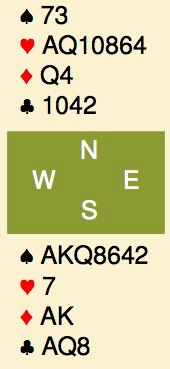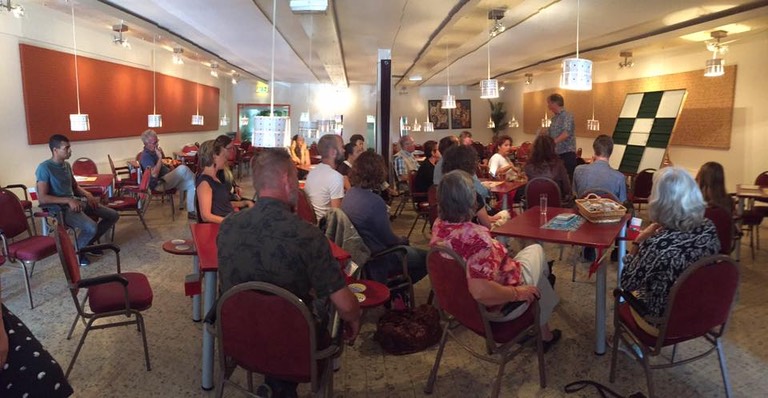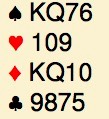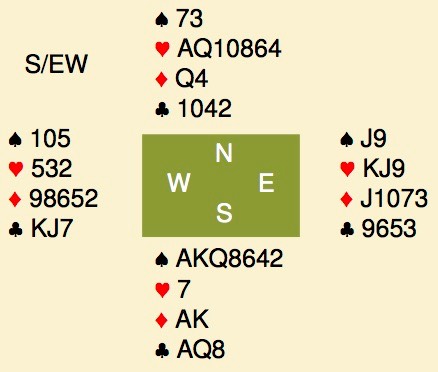For me, the last weekend had bridge at every level, from absolute beginners, to the start of the world championships in Wroclaw on Sunday morning. On Sunday morning, you log in to BBO for vuegraph and one of the first hands you see is this one. You are in 6♠ after a strong 2♣, heart response and 1 keycard from partner. West leads the ♦8, 2nd or 4th best. Plan the play.
You are in 6♠ after a strong 2♣, heart response and 1 keycard from partner. West leads the ♦8, 2nd or 4th best. Plan the play.
Last Saturday, the local club “de Denktank” organized an event for bridge-players and their non playing friends. The idea was that regular players invited a friend, family member, colleague or whoever for an introduction to the game. No knowledge of bridge was required by the newbee, just an interest in playing cards or games. Some 28 pairs showed up for a fun afternoon.
What happened this afternoon? Well, first Ruurd, the club owner and teacher, gave a 1 hour introduction to the game. That is obviously too short to explain the whole game, but it is sufficient to touch the basics:  the concept of a trick, the concept of trumps and no trumps, the concept of bidding, some hints about counting tricks and making more tricks than cashing aces, and a very simple bidding language aimed at finding trumps and the right level. On the right, you see the newbees listing to Ruurd, more pictures are on the facebook page of “de Denktank”. After an hour, a 16 board game was played. The newbees sat south or east, the regular players north or west. The regulars make sure that the game proceeded and took care of trivial things like getting the right boards and entering the results, but were not supposed to interfere otherwise.
the concept of a trick, the concept of trumps and no trumps, the concept of bidding, some hints about counting tricks and making more tricks than cashing aces, and a very simple bidding language aimed at finding trumps and the right level. On the right, you see the newbees listing to Ruurd, more pictures are on the facebook page of “de Denktank”. After an hour, a 16 board game was played. The newbees sat south or east, the regular players north or west. The regulars make sure that the game proceeded and took care of trivial things like getting the right boards and entering the results, but were not supposed to interfere otherwise.
The bidding language was simple but effective. First the point-count was explained. The boards were generated such that dealer always had an opening bid, i.e. 13 or more points, which is easy to arrange if you have a computer to deal the hands. Then, dealer was allowed to ask 3 questions to his partner:
- How many points do you have?
- How many spades do you have?
- How many hearts do you have?
At that point, he had to select the contract: 4♥/♠ with 8 or more trumps and 25 or more points, 3NT with 25 or more points, and a partscore in NT, ♠ or ♥ otherwise. Game meant 9 or 10 tricks, a partscore was at least 7 tricks. Play then proceeded as usual.
This is a fun way to get started. After an hour, you get to touch the cards. Never mind that you haven’t heard about a finesse, vulnerability or even the score, that is something one will discover later. Scoring is standard, though it is sufficient to explain that game brings in a huge bonus, overtricks are irrelevant and going costs points. And for expericienced players, there is a challenge in here too, you’ll soon discover that this is the ultimate relay system, with declarer’s hand always completely unknown.

A Balanced 81 Count.
The wife had invited her friend L to join. L. does play cards on a regular basis, a game known here as “jokers”, with her husband and grandson. I’m not going to bother you with the details of that game, but it is useful to know that all the spot cards there count at face values, that is 10 points for a 10 and 2 for a 2. G. dealt and asked L. “how many points do you have?”. That was simple a few honnors at the 4-3-2-1 scale, 10 or so spot cards is a bit more than one has in the “jokers” game, but after a few seconds, she had the answer: 81. The answer was correct, by the way, and it does prove that it is hard to explain everything fully in an hour.
Obviously a lot more things went wrong and somebody eventually won (full results), but that is besides the point. The point was that 28 newbees got to play their first hands and see that playing bridge can be quite fun. Afterwards a fair number enquired about a full course. If you are in the Arnhem region: one will start september 21st, contact Ruurd (info@bridgearnhem.nl or 06-15964839) at the Denktank for more information.
Obviously, you can try this at home with a few non-playing friends. The explanation above should be enough to get started, all you need is a deck of cards or preferably a set of boards. With a set of boards, deal in advance and switch a hand or two around so declarer has an opening bid. Without boards, modify the rule that dealer starts asking, by one that the first player with 13 or more points starts asking.

At the other side of the bridge spectrum are this years world championships, in the past known as the Olympiad, now called the 2016 World Bridge Games. They started on Sunday morning in Wroclaw, Poland. It is played in 4 categories, open, women, seniors and mixed, the latter being a new event. The first observation: the Netherlands does not play in the seniors category, which seems absurd considering that half the federation is eligible to play and Wroclaw is only a few hours drive from here. Equally absurd, in particular since the NBB labelled the team as a favorite for the title, the Dutch mixed team had to find their own sponsor to cover the costs.
The open teams compete for the Rosenblum cup. The first time this event was played, 1978, it was won by Poland. 38 years later, I’m sure that they want to repeat that. The team is the same as the team that won the Bermuda Bowl last year but also surprised most observers by not qualifying for the 2017 Bermuda Bowl last June. That probably adds a revenge element to their game.
One of the first hands, from the opening match between Poland and Tunesia on BBO and Vuegraph. In the closed room, the Poles stopped in 4♠, open Tunesia decided to bid 2 levels higher. ♦8, 2nd and 4th, and it is up to you.
There are 2 straightforward options to play the hand: a ♥ or a ♣ finesse, both 50%. Get it wrong and you have only 11 tricks. This is what happened to the Polish declarer in 4♠, but that didn’t matter much. The Tunesian declarer must have decided that it is not that often that his country makes it on vuegraph, thought about it a bit longer and found a better line.
Trick 1 ran to the ♦A, and declarer played 6 rounds of spades. Trumps split 2-2, west discarded 5♦’s, east 4♦’s and a club. That is a hint that ♣K is offside. Next declarer cashed the ♦K, west discarding a heart. That suggests that the ♥K is offside as well. It also gives a full count of the west hand: 2♠, 5♦, 2 or 3♥ and 3 or 4♣. North, by interference, has 2♠, 3 or 4♥, 4♦ and 4 or 5♣. You know the distribution, but not the location of the high cards, see diagram on the right. Declarer now played his last spade, crossed to the ♥A, stripping west’s hearts. Next the ♣10, when east couldn’t cover, played the 8. (And if east does cover, declarer plays the ♣Q, for the same result). West won but was forced to lead from his ♣K.
It may appear that west can avoid this by keeping red card, but that is not true. He then has to reduce his clubs to ♣Kx and declarer can simply make by playing the ♣A and a club. Finally, this line also works when north has the ♣K. Oh, yes, a heart lead beats the contract, but that is not easy to find after a heart positive response.
Well done, for a 13 imp pick-up, as the fulll hand was this. While this cost 13 imps, Poland did win the match by 63-31, or 17.03-2.97.
While this cost 13 imps, Poland did win the match by 63-31, or 17.03-2.97.
I’ll be logged in to BBO a lot this week, my nickname there is HAJRU, so feel free to chat if you like. As I’m writing this, Bas and Sjoert (finally in the lineup after 2 days), made their first doubled contract and are about to collect a nice penalty, so I’m sure that there are interesting hands for another blog.
